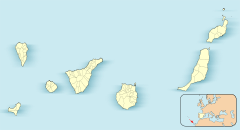Vacuum Tower Telescope
 The VTT at the Teide Observatory, Tenerife. | |
| Part of | Teide Observatory |
|---|---|
| Location(s) | Tenerife, Canary Islands, Spain |
| Coordinates | 28°18′08″N 16°30′36″W / 28.30233°N 16.51003°W |
| Organization | Leibniz Institute for Astrophysics Potsdam Leibniz Institute for Solar Physics Max Planck Institute for Solar System Research |
| First light | 1988 |
| Telescope style | optical telescope solar telescope |
| Diameter | 70 cm (2 ft 4 in) |
| Focal length | 46 m (150 ft 11 in) |
| Mounting | altazimuth mount |
| Enclosure | turret |
| Website | www |
| | |


The Vacuum Tower Telescope is an evacuated-optics solar telescope located at the Teide Observatory on Tenerife in the Canary Islands. It is operated by the Kiepenheuer-Institut für Sonnenphysik (KIS).[1][2]
It was built between 1983 and 1986, with first light in 1988.[3] It has a 70-centimetre (28-inch) diameter primary mirror and a focal length of 46 metres (151 ft). Thanks to an adaptive optics system KAOS (Kiepenheuer-institute Adaptive Optic System), in operation since spring 2000,[4][5] it is able to resolve details down to 0.2 arc seconds (150 km) on the Sun's surface.[6][7][8]
Description
[edit]The VTT and the GREGOR are operated by four German institutes: the Astrophysikalisches Institut Potsdam, the Kiepenheuer-Institut für Sonnenphysik (Freiburg, chair), the Max-Planck-Institut für Sonnensystemforschung (Lindau), and the Universitäts-Sternwarte Göttingen. The telescope is used for scientific observations from mid April through mid December. Typically 30 to 40 observing campaigns are carried out every year.
History
[edit]In the early seventies, the 40cm Newton-telescope, built at the Kiepenheuer-Institut, was installed at the Observatorio del Teide. In 1982, the Federal Republic of Germany joined the international Agreement on the Cooperation in Astrophysical Research between Spain, Great Britain, Sweden and Denmark. Construction work for the German solar telescopes started in 1983, including the Vacuum Tower Telescope (VTT), and the Gregory-Coudé-Telescope (GCT) of the Universitäts-Sternwarte Göttingen. The VTT has been developed at the Kiepenheuer-Institut in Freiburg during the mid seventies. The telescope was installed in 1986 and the scientific operations started in 1988. Since then, the VTT has been constantly improved and has been the ?working horse"" for our researchers. The GCT was put into operation in 1985 and was finally dismantled in 2002, in order to make room for the new 1.5m-telescope GREGOR.
Results
[edit]The VTT instrumentation is designed for high-quality measurements of plasma flows and magnetic fields. Some instruments can be combined for simultaneous observations in different parts of the solar spectrum, from the near infrared to the near UV. This possibility is a unique feature for a solar telescope and allows to reveal the three-dimensional structure of the solar atmosphere. With the help of adaptive optics and suitable image reconstruction techniques it is now possible to observe physical properties of small-scale objects on the solar surface with sizes of only 150 km, at the theoretical limit of the telescope. The pictures show a small region of the solar surface with two dark pores. The panel on the right shows how the plasma moves: red is downward motion and blue is upward, the total range is from -1.4 km/s to +1.4 km/s.
See also
[edit]References
[edit]- ^ Kiepenheuer-Institut für Sonnenphysik (KIS)
- ^ "Vacuum Tower Telescope". KIS website. Kiepenheuer-Institut für Sonnenphysik. Retrieved 11 January 2014.
- ^ "Vacuum Tower Telescope (VTT)". IAC website. Instituto de Astrofísica de Canarias. Retrieved 11 January 2014.
- ^ "KAOS- The Kiepenheuer-institute Adaptive Optic System". Archived from the original on June 10, 2007. Retrieved May 31, 2007.
- ^ "Solar observations of highest resolution obtained with Adaptive Optics and Speckle-Interferometry at the VTT". Archived from the original on June 10, 2007. Retrieved May 31, 2007.
- ^ Van Der Luehe, Oskar; Soltau, Dirk; Berkefeld, Thomas; Schelenz, Thomas (2003). "KAOS: Adaptive optics system for the Vacuum Tower Telescope at Teide Observatory". In Keil, Stephen L.; Avakyan, Sergey V. (eds.). Innovative Telescopes and Instrumentation for Solar Astrophysics. Vol. 4853. p. 187. Bibcode:2003SPIE.4853..187V. doi:10.1117/12.498659. S2CID 120643967.
- ^ Berkefeld, Thomas; Dirk Schmidt (December 2012). "KAOS - a flexible control system for AO and MCAO" (PDF). Real Time Control for Adaptive Optics Workshop. 2. Garching: ESO. Retrieved 11 January 2014.
{{cite journal}}: Cite journal requires|journal=(help) - ^ Rimmele, Thomas R.; Jose Marino (2011). "Solar Adaptive Optics". Living Reviews in Solar Physics. 8 (2): 2. Bibcode:2011LRSP....8....2R. doi:10.12942/lrsp-2011-2. PMC 4841189. PMID 27194964.

